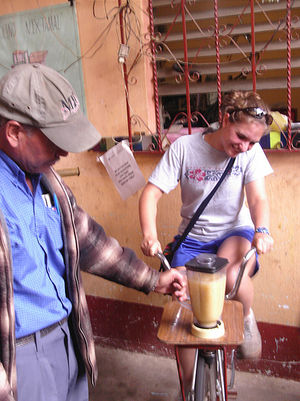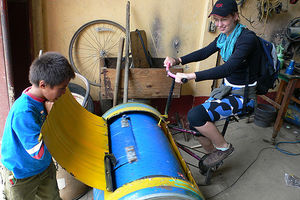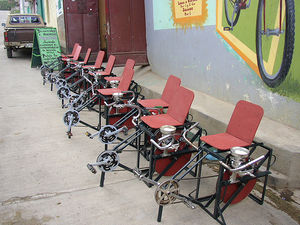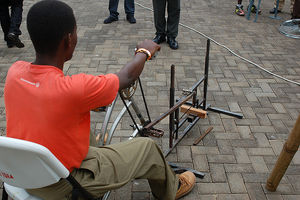Bicycle technology: Difference between revisions
No edit summary |
(→Links) |
||
| (31 intermediate revisions by 6 users not shown) | |||
| Line 1: | Line 1: | ||
{{Category=Energy}} | |||
[[File:mayapedal01.jpg|300px|thumb|right|Trying out the bike blender at Maya Pedal]] | |||
[[File:mayapedal02.jpg|300px|thumb|right|Washing day - Sophie tests the pedal powered washing machine at Guatemala´s pedal powered technology organisation Maya Pedal]] | |||
[[File:mayapedal03.jpg|300px|thumb|right|''bicimaquinas'' at Maya Pedal, lining up for work]] | |||
[[File:bikeparts01.jpg|300px|thumb|right|Bicycle Hacksaw - Bernard Kiwia of Tanzania, a bicycle mechanic, creates many tools from bicycle parts. This is his hacksaw creation. ]] | |||
Bicycle technology (''"biketech"'') is the extension of the basic components of bicycle construction to a larger field of uses. Power delivered to pedals (by arms, legs, or other source of motion), transmitted by bicycle chains, drive cables, and/or bicycle gears is applied to power machines or generate electricity. The supplied motion may be used for transport, pumping water, vacuum pumping, seed winnowing, blending food, mowing grass, spinning washing machines, and so on. Thus, without the infrastructure for electricity or internal combustion, the motive power of human beings can be multiplied and extended to alleviate tedious tasks in agriculture. When all aspects are considered, this technology is probably much less expensive than the current electric way of doing things (build-out for electric infrastructure, mining copper for electric motors, burning fossil hydrocarbons in power plants causing climate disruption etc.). | |||
# | ==Set of Components== | ||
The set of components utilized in bicycle technology is the simplest set that will enable a human to power a broad range of mechanized devices. This set of components is includes but is not limited to: | |||
#simple gears | |||
#chain links | #chain links | ||
#crank arms (from pedal to gear) | #crank arms (from pedal to gear) | ||
| Line 15: | Line 22: | ||
All of these (except drive belts) are castable or extrudable if a group has metal working technology. However, due to the fact that these parts rarely physically fail and are widely interchangeable, a small casting/extruding operation would likely supply a large population. The commonness of certain larger units, such as forks for holding wheels/pulleys, increases the reusability of parts. Individual devices would require additional components, such as for pumps, blowers, or threshers, which could be manufactured with similar infrastructure. | All of these (except drive belts) are castable or extrudable if a group has metal working technology. However, due to the fact that these parts rarely physically fail and are widely interchangeable, a small casting/extruding operation would likely supply a large population. The commonness of certain larger units, such as forks for holding wheels/pulleys, increases the reusability of parts. Individual devices would require additional components, such as for pumps, blowers, or threshers, which could be manufactured with similar infrastructure. | ||
[http://www.mayapedal.org/ | ==Maya Pedal== | ||
[http://www.mayapedal.org/ Maya Pedal] is a group in Guatemala employing bicycle technology for a large variety of uses amongst agrarian and city folks. The organization has [http://www.mayapedal.org/machines.html extensive '''open source''' downloadable design information] on their website. Applications with proven implementation: | |||
*water (rope) pump | |||
*corn grinder | |||
*nut sheller | |||
*blender | |||
*microconcrete vibrator for roofing tiles | |||
*coffee depulper | |||
*metal sharpener | |||
*washing machine | |||
*12V electricity generator (prototype exists, but there are no plans on the site. You could use the same generator mechanism as [[Small Wind Turbine|open-source wind turbines]], but get rid of the turbine blades, and stick the axle of the bike in there instead. | |||
*soil plow/till/hoe | |||
*wood saw | |||
<html> | |||
<iframe title="YouTube video player" class="youtube-player" type="text/html" width="640" height="390" src="https://www.youtube.com/embed//gJVThyebOB4" frameborder="0"></iframe> | |||
</html> | |||
==Open-source designs== | |||
*[http://www.appropedia.org/WaterPod_Bicycle_Energy_Generator WaterPod Bicycle Energy Generator]. Costs about $150 to build. Generates around 150W. Full build instructions and bill of materials available under Creative Commons license. | |||
*[http://www.appropedia.org/Rowan's_portable_pedal_power_generator Rowan Steele's portable pedal power generator]. Cost $300, but could probably be done for less. | |||
*Attachment that fits on to a normal bicycle allowing it to be used for pedal-powered machines: [http://www.appropedia.org/Standard_bicycle_with_pedal_power_attachment] | |||
==Product Ecology and more Ideas== | |||
* [[:Category:Metalworks|metallurgy]] and [[:Category:Digital Fabrication|digital fabrication]] are needed to manufacture the components | |||
* [[Compressed_Air|compressed air]] and [[hydraulic motors]] as an alternative (perhaps preferred) way to power these devices - is it possible to design a '''single power interface''' to use whatever energy is available ??? (i.e. small hydro, wind, biomass, steam engine, human or animal muscle, etc. This would be a big achievement. | |||
* possibility of hydraulic transmission rather than chain. Some people, such as [http://www.hydrocad.com/ this guy], are using this technology to create [http://en.wikipedia.org/wiki/Hydraulic_bicycle hydraulic bicycles]. | |||
* idea: [[Wheeled Construction Shovel|wheeled construction shovel]] | |||
== Links == | |||
* Book by Tamara Dean: [http://www.thehumanpoweredhome.com/ "The Human-Powered Home"] | |||
* Low-tech Magazine: [http://www.lowtechmagazine.com/2011/05/pedal-powered-farms-and-factories.html Pedal powered farms and factories: the forgotten future of the stationary bicycle] | |||
* [http://ltras.ucdavis.edu/itech-appropriate-technology-for-small-and-subsistence-farms-1/ Itech] at UC davis offers plans for many useful devices which could be bicycle powered. | |||
* Appropedia [http://www.appropedia.org/Category:Pedal_power Category on Pedal Power] - contains open-source plans for a few pedal-powered generators | |||
* Christoph Thetard: [http://www.christoph-thetard.de/christoph-thetard.de/R2B2-engl.html "Kitchen Machines"] | |||
* [http://d-lab.mit.edu/courses/cycle-ventures MIT D-Lab "Cycle Ventures"] | |||
* [http://www.mayapedal.org Maya Pedal Powered Machines in Guatemala] | |||
* Treehugger: [http://www.treehugger.com/renewable-energy/bicimaquinas-bike-machines-guatemala.html "Bicimaquinas: The bike machines of Guatemala"] | |||
* [http://etracab.ru/forum/viewprintable.php?id=3258 web page in Russian] with a '''*LARGE*''' collection of ergonomic human powered (and electric) harvesting, gardening, homesteading carts and aids. | |||
[ | ==See Also== | ||
*[[Transportation]] | |||
*[[Road]] | |||
[[Category: | [[Category:Vehicles]] | ||
Latest revision as of 16:19, 27 June 2016
Bicycle technology ("biketech") is the extension of the basic components of bicycle construction to a larger field of uses. Power delivered to pedals (by arms, legs, or other source of motion), transmitted by bicycle chains, drive cables, and/or bicycle gears is applied to power machines or generate electricity. The supplied motion may be used for transport, pumping water, vacuum pumping, seed winnowing, blending food, mowing grass, spinning washing machines, and so on. Thus, without the infrastructure for electricity or internal combustion, the motive power of human beings can be multiplied and extended to alleviate tedious tasks in agriculture. When all aspects are considered, this technology is probably much less expensive than the current electric way of doing things (build-out for electric infrastructure, mining copper for electric motors, burning fossil hydrocarbons in power plants causing climate disruption etc.).
Set of Components
The set of components utilized in bicycle technology is the simplest set that will enable a human to power a broad range of mechanized devices. This set of components is includes but is not limited to:
- simple gears
- chain links
- crank arms (from pedal to gear)
- bearings
- braided wire (for lever based controls)
- levers (for lever based control)
- pulleys/wheel frames
- drive belts
- metal tubes (welded to make frames)
All of these (except drive belts) are castable or extrudable if a group has metal working technology. However, due to the fact that these parts rarely physically fail and are widely interchangeable, a small casting/extruding operation would likely supply a large population. The commonness of certain larger units, such as forks for holding wheels/pulleys, increases the reusability of parts. Individual devices would require additional components, such as for pumps, blowers, or threshers, which could be manufactured with similar infrastructure.
Maya Pedal
Maya Pedal is a group in Guatemala employing bicycle technology for a large variety of uses amongst agrarian and city folks. The organization has extensive open source downloadable design information on their website. Applications with proven implementation:
- water (rope) pump
- corn grinder
- nut sheller
- blender
- microconcrete vibrator for roofing tiles
- coffee depulper
- metal sharpener
- washing machine
- 12V electricity generator (prototype exists, but there are no plans on the site. You could use the same generator mechanism as open-source wind turbines, but get rid of the turbine blades, and stick the axle of the bike in there instead.
- soil plow/till/hoe
- wood saw
Open-source designs
- WaterPod Bicycle Energy Generator. Costs about $150 to build. Generates around 150W. Full build instructions and bill of materials available under Creative Commons license.
- Rowan Steele's portable pedal power generator. Cost $300, but could probably be done for less.
- Attachment that fits on to a normal bicycle allowing it to be used for pedal-powered machines: [1]
Product Ecology and more Ideas
- metallurgy and digital fabrication are needed to manufacture the components
- compressed air and hydraulic motors as an alternative (perhaps preferred) way to power these devices - is it possible to design a single power interface to use whatever energy is available ??? (i.e. small hydro, wind, biomass, steam engine, human or animal muscle, etc. This would be a big achievement.
- possibility of hydraulic transmission rather than chain. Some people, such as this guy, are using this technology to create hydraulic bicycles.
- idea: wheeled construction shovel
Links
- Book by Tamara Dean: "The Human-Powered Home"
- Low-tech Magazine: Pedal powered farms and factories: the forgotten future of the stationary bicycle
- Itech at UC davis offers plans for many useful devices which could be bicycle powered.
- Appropedia Category on Pedal Power - contains open-source plans for a few pedal-powered generators
- Christoph Thetard: "Kitchen Machines"
- MIT D-Lab "Cycle Ventures"
- Maya Pedal Powered Machines in Guatemala
- Treehugger: "Bicimaquinas: The bike machines of Guatemala"
- web page in Russian with a *LARGE* collection of ergonomic human powered (and electric) harvesting, gardening, homesteading carts and aids.



